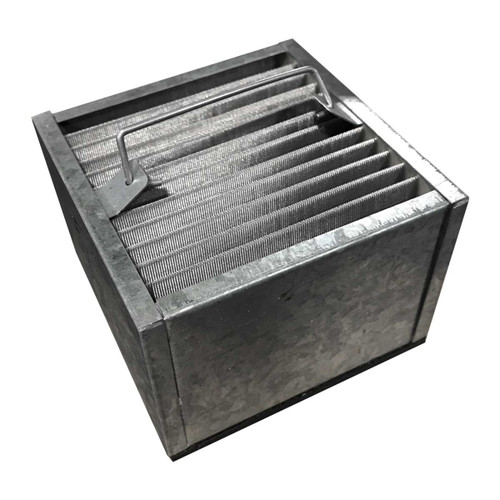Commercial Application: Recommended for up to 400 gallons of diesel fuel (can vary depending on piping installation).
Available as wall mount to fit inside the generator enclosure, or with enclosure (part # 18-3264-01) and stand (part # 14-3920-01) for outdoor installations.
Eliminates sludge and water buildup in the tank.
99.9% Water separation (Certified TUV report using SAE J1839)
99% Particulate removal
Equipped with digital timer to program a weekly schedule.
Shutdown and alarm for high vacuum and water.
Technical Specifications
Flow Rate: 80 GPH / 303 LPH
Voltage: 24V
Inlet/Outlet: 1/2" #8 Male JIC
Lift: 4 ft / 1.22m
Primary Filtration: 30 micron
Secondary Filtration: 2 micron
Base: Powerdercoated aluminum
Cover: Powerdercoated aluminum
User Manual
Fuel Polishing Systems FAQs
How do you know that diesel is flowing from inlet to outlet? Is there a minimum reading on the vacuum gauge to indicate that?
You cannot tell from the vacuum gauge if fuel is flowing. The pumps are capable of creating a vacuum in the filters when fuel is NOT present. One method for determining if flow is present is to check the discharge hose. When you first start the unit, you listen to the pump. Depending upon the length of your inlet hose, and the height of the suction lift, it will take from 30 seconds up to a minute to take suction. As liquid reaches the pump you will hear a change in pitch and volume from the pump. At the same time, you will see the black needle on the vacuum gauge move to the left. How far this move is a function of the length and diameter of the hose, as well as the height of the suction lift. The lower the number the better, as the gauge reads the total system vacuum, and not the condition of the filter. The best method for determining flow, and measuring it, is to install our optional flow meter to the outlet of the system.
How do I prime the fuel system?
If the pump does not take prime in the first minute, or this is the first time the unit has been run, it may be necessary to prime the system. There are several ways in which to do this.
Perhaps the easiest way to do this is to attach a very short hose to the inlet of the system, and place the hose into a container of diesel fuel, start the system, and allow the pump to run until the 2-3 gallons of fuel have been moved thru the system. If this is not possible, remove the lid of the filter, remove the filter element and spring cage.
Instructions for removing the lid, and filter element are contained in your operating manual.
Manually fill the filter housing with clean diesel fuel. Replace the filter element, and spring cage. Re-install the lid and tighten lid screws to proper torque.
Proper torque specifications are located in your operating manual.
It is suggested to install a foot valve, check valve, or non-return valve to ensure that system maintains its prime after initial prime.
How do I size a fuel polishing system for my tank?
This is a general guideline when the system is installed beside the tank. If the application has multiple tanks or the system will be installed away from the tank please contact ui
Use the following tank chart:
Tank (Gallons) |
Suggested Model |
up to 400 |
FPS-80, AFP-80 |
300-500 |
FPS-150, AFP-150, Fuel Polishing Module |
500-1,000 |
FPS-150, AFP-150 |
1,000-5,000 |
FPS-210, AFP-210, AFP-600, Diesel Fuel Service Cart |
5,000-10,000 |
AFP-600, Diesel Fuel Service Cart, FPS-2000, AFP-2000 |
10,000+ |
FPS-2000, AFP-2000 |
How far away can the fuel polishing system be from the tank?
The system should be installed beside the tank or as close as possible. The longer the distance from the tank to the pump, the stronger the system required. If you are unsure which model to choose, contact us at (954) 522-0882 for Technical Assistance.
How high can the system be installed above the tank?
Because the pumps are limited in the vertical lift it is necessary to know the depth of the lowest point of the tank. Systems are limited to the following:
FPS-80 and AFP-80 = 4 ft.
FPS-150 and AFP-150 = 10 ft.
FPS-210 and AFP-210 = 15 ft.
FPS-600 and AFP-600 = 15 ft.
We also recommend installing a non-return foot valve on the suction side.
How long should I run the polishing cycle?
For the first time, we recommend turning the fuel three times. Therefore, for a 100 gallon tank, with a 150 GPH system, will need to run for two hours.
Run Cycle =
Volume of the tank x 3
Flow Rate of the FPS
Afterwards, the system can be run to cycle the fuel tank once per month, or more frequently based upon the environment, tank-housekeeping, and usage.
How long should the suction and return line be?
Suction line must extend to the bottom of the tank (distance from bottom is 1/2 the hose diameter) and should not be connected to any other equipment. It must have a check valve as it leaves the tank. This prevents flow back which can leave the filter empty.
Return line must extend into the fuel. We suggest no less than two thirds the depth of the tank. This does three things:
- Prevents fuel from picking up air as it splashes into the tank accelerating the oxidation of the fuel
- Prevents foaming of the tank which can lead to overflow
- Prevents air entering the filtration loop which can cause the loss of prime
How long will the element last? How often should I replace the element?
How dirty is your fuel? Unfortunately, there is no single answer this question.
The time it takes before the filter element reaches max dirt load can vary from 10 minutes to 300 hours. It is completely dependent on the dirt load and type of contamination in the tanks.
Often, we find masses of solids settle in the bottom of tanks, and these can clog elements, quickly. It is for this reason that we have the 60-micron Stainless Steel element. This can simply be backflushed, a procedure detailed in the operating manual.
When clogged, the stainless-steel element can be removed, and cleaned for reuse. When using our standard 10 or 30-micron paper elements, the number of times it can be backflushed depends on the type (sticky or not) of dirt lodged in the element.
In some installations in the U.S., where the fuel is like water, we have customers that replace the filter element only once per year in a permanent installation.
For mobile tank cleaning where the tank is dirty to begin with, we recommend the use of the 60-micron stainless steel element. This can be removed and cleaned many, many times. It is best to have two stainless steel elements, so that the machine can continue to work during the element cleaning process.
Once the 60-micron filter comes out clean, then you can switch to the 30-micron paper element and continue the process. This will prevent the expenditure of a large number of paper elements.
Is there Dry Run protection for the pump?
The pump is not equipped with "Dry Run" protection. The operator must pay attention to the system. Normally, our systems are used to circulate fuel in a tank - pull fuel from the tank, and return it to the same tank.
In this scenario, it would be very unlikely that the pump would ever run dry.
If your application is different, (such as pulling fuel from multiple tanks or using the system as a clean fuel dispenser), then running the tank / pump dry is more likely.










